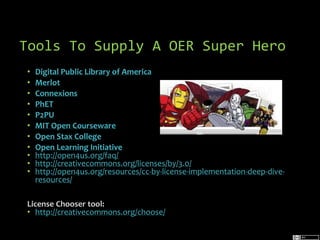OER-Benefit Verses Cost
- 1. OER Benefit Verses Cost March 3, 2014 Brenda M. Perea
- 2. When you use OER: • You feel like a super hero delivering high quality content at “no cost” • Why a super hero? Super Hero by demandaj published under a CC BY-NC-SA-2.0 license • Open source material can be taken, reused, revised, remixed, republished, and reorganized as needed as long as you follow the creative commons license • Digital course content is compiled and edited by the instructor for other instructors • Content is presented and delivered predominantly in multimedia friendly formats through the Internet • Digital OER textbooks, text readings are reduced and condensed compared to regular textbooks • Updating is instant and constant on an on-going basis • OER Repositories are often “peer reviewed” for quality
- 3. Tools To Supply A OER Super Hero • • • • • • • • • • • Digital Public Library of America Merlot Connexions PhET P2PU MIT Open Courseware Cool Toy Pics of the Day by rosefirerising is published under a Open Stax College CC BY-NC-ND 2.0 license Open Learning Initiative http://open4us.org/faq/ http://creativecommons.org/licenses/by/3.0/ http://open4us.org/resources/cc-by-license-implementation-deep-diveresources/ License Chooser tool: • http://creativecommons.org/choose/
- 4. Challenges to Using and Contributing • Technology—OER is viewed as a new technology and doesn’t have wide to OER acceptance as publisher content • OER Repositories—Are not built on the same platform such as HTML vs. XML and sharing to an OER Repository requires manual recreating of content since SCORM uploads are not standard. • Time—takes an enormous amount of time to find OER, confirm the creative commons licenses and then adapt the OER for your specific needs. • Quality Assessment—OER is voluntary, there is a reluctance to “share” and the reluctance to “accept other work as equivalent as publisher created work” Super Villain by tikigod published under a CC BY-NC-ND-2.0 license • College and University Property—who actually “owns” the content created within a college or university system. • academic freedom often prevent the acceptance and sharing of open access licenses • Following or Creating a different CC BY license for each OER published • No Central OER repository--Videos: YouTube, Vimeo or the Internet Archive, Audio/Podcasts: Soundcloud or the Internet Archive. Presentations: Slideshare, Documents: Google Drive 4
- 5. Creative Commons Attribution • OER-Benefit verses Cost Brenda M. Perea is licensed under a Creative Commons Attribution 4.0 International License.
Editor's Notes
- TechnologyTimeQuality Assessment-Reluctance to “share” and the reluctance to “accept other instructors work”Policies on academic freedom, open access licenses (CC BY)Development of a master course with core competencies coveredEvolving Online/Hybrid Pedagogy QualityDiffering learning management systemsResistance to being required to publish Online/hybrid courses as OEREvolving Online/Hybrid Pedagogy Differing learning management systems




